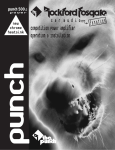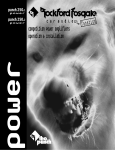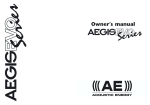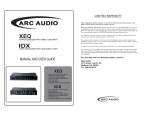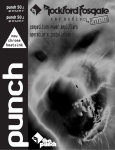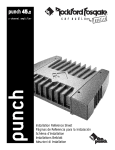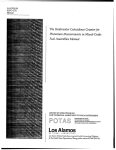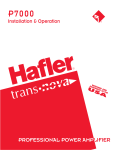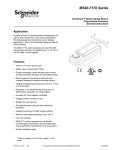Download Rockford Fosgate 225.2 User's Manual
Transcript
trans•ana
®
®
car audio
trans•ana
t r a n s • a n a
punch
t r a n s • a n a
for
fanatics
2-Channel Amplifiers
Operation & Installation
®
Dear Customer,
Congratulations on your purchase of the world's finest brand of car audio amplifiers.
At Rockford Fosgate we are fanatics about musical reproduction at its best, and we are
pleased you chose our product. Through years of engineering expertise, hand craftsmanship and critical testing procedures, we have created a wide range of products that
reproduce music with all the clarity and richness you deserve.
For maximum performance we recommend you have your new Rockford Fosgate
product installed by an Authorized Rockford Fosgate Dealer, as we provide specialized
training through Rockford Technical Training Institute (RTTI). Please read your
warranty and retain your receipt and original carton for possible future use.
Great product and competent installations are only a piece of the puzzle when it comes
to your system. Make sure that your installer is using 100% authentic installation
accessories from Connecting Punch in your installation. Connecting Punch has
everything from RCA cables and speaker wire to Power line and battery connectors.
Insist on it! After all, your new system deserves nothing but the best.
To add the finishing touch to your new Rockford Fosgate image order your Rockford
wearables, which include everything from T-shirts and jackets to hats and sunglasses.
To get a free brochure on Rockford Fosgate products and Rockford accessories, in the
U.S. call 602-967-3565 or FAX 602-967-8132. For all other countries, call +001-602967-3565 or FAX +001-602-967-8132.
PRACTICE SAFE SOUND™
CONTINUOUS EXPOSURE TO SOUND PRESSURE LEVELS OVER 100dB
MAY CAUSE PERMANENT HEARING LOSS. HIGH POWERED AUTOSOUND
SYSTEMS MAY PRODUCE SOUND PRESSURE LEVELS WELL OVER
130dB. USE COMMON SENSE AND PRACTICE SAFE SOUND.
If, after reading your manual, you still have questions regarding this product,
we recommend that you see your Rockford Fosgate dealer. If you need further
assistance, you can call us direct at 1-800-669-9899. Be sure to have your serial
number, model number and date of purchase available when you call.
The serial number can be found on the outside of the box. Please record it in
the space provided below as your permanent record. This will serve as
verification of your factory warranty and may become useful in recovering your
amplifier if it is ever stolen.
Serial Number: ________________________________
Model Number: ________________________________
TABLE
CONTENTS
OF
Introduction ................................................................................................ 1
Punch Amplifier Accessory Pack ................................................................... 1
Technical Design Features ............................................................................ 2
Design Features .......................................................................................... 5
Installation Considerations ........................................................................... 7
Mounting Location ...................................................................................... 8
Battery and Charging .................................................................................. 9
Wiring the System ....................................................................................... 9
Using Passive Crossovers ........................................................................... 12
Table of Component Values ........................................................................ 13
Using the XCard ........................................................................................ 14
Resistor Chart ........................................................................................... 15
Installation ............................................................................................... 16
System Diagrams ...................................................................................... 20
Rockford Fosgate Accessories ..................................................................... 24
Troubleshooting ........................................................................................ 26
Dynamic Power Measurements ................................................................... 29
Specifications ........................................................................................... 31
Warranty Information ................................................................................ 33
International Information ............................................................................ 34
GETTING STARTED
Welcome to Rockford Fosgate! This manual is designed to provide information
for the owner, salesperson and installer. For those of you who want quick
information on how to install this product, please turn to the Installation
Section of this manual or refer to the icons listed below. Other information can
be located by using the Table of Contents. We, at Rockford Fosgate, have
worked very hard to make sure all the information in this manual is current. But,
as we are constantly finding new ways to improve our product, this information
is subject to change without notice.
a
d
v
a
n
c
e
d
O
p
e
r
a
t
i
o
n
Sections marked
ADVANCED OPERATION
include in-depth
technical information
®
®
I
N
S
T
A
L
L
A
T
I
O
N
Sections marked
INSTALLATION
include “slam dunk”
wiring connections
TROUBLE-S
H
O
O
T
I
N
G
Sections marked
TROUBLESHOOTING
include recommendations for
curing installation problems
INTRODUCTION
Rockford engineers designed the Punch 55.2, 75.2, 125.2 and 225.2
amplifiers to withstand the rugged automotive environment while delivering
superior sound quality in a flexible, reliable, and efficient package. TRANS•ANA
is a low voltage circuit in the preamp stage of all Punch .2 amplifiers that
lets the music sound crystal clear and very real, even when played at high
volume levels. This is matched with TOPAZ, a unique grounding circuit used
to eliminate noise problems associated with car audio systems and their
installation. Flexibility is accomplished with the use of a built-in XCard.
Reliability is all but guaranteed with the use of a protection circuit called
NOMAD, while MOSFET and DSM (Discrete Surface Mount) technology
improve amplifier efficiency. The result of these components give the Punch
amplifier awesome sound quality in a “Bullet Proof” package. An explanation of these technologies, most of which are exclusively designed and
patented by Rockford, are described in the Technical Design Features.
P UNCH A MPLIFIER A CCESSORY P ACK
The accessory pack shipped with the Punch 2-channel amplifiers includes
the mounting hardware necessary to secure the amp to the vehicle and to
attach the end caps to the amplifier.
Installation & Operation Manual
Punch Verification Certificate
(4) Amplifier mounting screws (#8 x 3/4" Phillips)
(6) Speaker & power connector screws (3/32" Allen)
(4) End cap mounting screws (9/64" Allen)
(1) Allen Wrench 9/64"
(1) Allen Wrench 3/32"
(1) ATC Inline Fuseholder (Punch 55.2, 75.2, 125.2)
(1) AGU Inline Fuseholder (Punch 225.2)
(1) ATC 20 Amp Fuse (Punch 55.2)
(1) ATC 30 Amp Fuse (Punch 75.2)
(1) ATC 40 Amp Fuse (Punch 125.2)
(1) AGU 50 Amp Fuse (Punch 225.2)
–1–
TECHNICAL DESIGN FEATURES
◆ TRANS•ANA
(TRANSconductance Active Nodal Amplifier)
The TRANS•ANA (TRANSconductance Active Nodal Amplifier) is a circuit
that allows the audio signal to pass through the amplifier at low voltage. The
signal is directly level-shifted to the fixed high voltage rails via a pair of driver
transistors. Signal linearity is assured by an active node formed by the drive
transistors at ultrasonic frequencies. This allows amplifier performance
similar to trans•nova which is highly stable and linear while utilizing the
advantages of a non-floating power supply.
THE RESULT: An extended frequency bandwidth accurately supplied to the
output stages of the amplifier.
◆ MEHSA (Maximum Efficiency Heat Sink Application)
The MEHSA (Maximum Efficiency Heat-Sink Application) is a proprietary
process that yields up to 5 times better heat transfer than traditional FET
mounting techniques using the exact same components. A multi-layer
insulated metal substrate operating with minimal thermal resistance spreads
heat both downward & outward to quickly dissipate heat from each device
across the heat sink. This process combined with our DSM technology and
MOSFET devices allow us to squeeze more watts per cubic inch from every
output device as well as provide consistent thermal stability.
THE RESULT: Optimized power output, enhanced thermal stability, and
maximum component reliability.
◆ TOPAZ (Tracking Operation Pre-Amplifier Zone)
The TOPAZ (Tracking Operation Pre-Amplifier Zone) circuitry solves ground
loop noise problems common to automotive amplifier design. This innovative
new development allows vastly improved isolation of the input signal grounds
from the power supply ground of the amplifier. This is accomplished by
allowing the source unit to control the potential “environment” of the entire
input structure or “zone” of the amplifier. This process improves the noise
rejection of the amplifier by 30-40dB – an astounding 30-100 times better
than amplifiers without TOPAZ.
THE RESULT: Elimination of troublesome ground loop noise between source
and amplifier.
–2–
◆ DSM (Discrete Surface Mount) Technology
The DSM (Discrete Surface Mount) manufacturing process combines the
advantages of both discrete components and integrated circuitry. Rockford
Fosgate is the only American amplifier manufacturer to have invested millions
into this process. DSM components differ from conventional discrete components in different ways. They are more compact, more rugged, and they
efficiently dissipate generated heat. Using them wherever appropriate allows
the advantages associated with discrete circuitry to be retained while also
providing room for both highly advanced processing features and generous
PC board copper paths where needed. Their short lead-out structures allow
maximum audio performance and highest signal-to-noise ratios to be
obtained in amplifiers of desirable package size without resorting to “amplifier-on-a-chip” shortcuts. These advantages are shown below in Figure 1.
THE RESULT: Fewer connections, improved reliability, shorter signal paths,
superior signal-to-noise ratio and awesome sonic performance.
Figure 1
Component
Solder
PC
Board
Solder
PC
Board
Thru-Hole
Surface Mount
◆ XCard (Internal Crossover)
The Punch amplifiers utilize internal active crossovers. These crossovers have
many performance advantages such as using discrete components for exact
frequency adjustments which are far superior to potentiometers. Additionally,
the XCard can be configured for high-pass, low-pass and full range
operation. With slight modifications, many crossover frequencies and slope
configurations can be achieved.
THE RESULT: Increased system design flexibility with a precise electronic
crossover without the limitations of conventional potentiometer designs.
–3–
◆ MOSFET Devices
Rockford Fosgate is one of the few manufacturers in the sound community
to utilize MOSFET devices in both the power supply and the output stages.
MOSFET (Metal Oxide Semiconductor Field Effect Transistor) devices offer
several important inherent advantages over the 30 year old technology of bipolar design. These advantages include: thermal stability, switching speed,
ultra low output impedance and wider bandwidth linearity. In addition,
MOSFETs operate very similarly to vacuum tubes in that they are more linear
than bi-polar transistors. However, MOSFETs can deliver the midrange clarity
without the limitations of transient response and high frequency phase
shifting normally associated with tube operation.
THE RESULT: Operational characteristics similar to vacuum tubes without
the performance limitations of tube design.
◆ NOMAD (NOn-Multiplying Advanced Decision)
The Punch amplifiers use an analog computer process to maximize safe
output power under all operating conditions. The innovative NOMAD (NOnMultiplying Advanced Decision) system is the most sophisticated version of
this technique ever used, bringing previously unavailable levels of accuracy,
stability, temperature immunity and reliability to this critical process. NOMAD
makes advanced decisions based on device voltages to precisely control the
awesome levels of current available in the output MOSFETs to safe values –
but only when absolutely needed.
THE RESULT: Extremely fast protection system that always protects the
amplifier and never degrades the sound.
◆ Punch EQ
The Punch EQ helps correct for acoustical deficiencies in the listening
environment. Two unique potentiometers that control bass and treble
compensate for the response errors present in most car environments. Unlike
conventional tone controls, Punch EQ corrects the specific problems of poor
low bass response and high frequency rolloff.
THE RESULT: Full range sound without excessive boost in areas where it is
not needed.
–4–
D ESIGN FEATURES
1. Cast Aluminum Heatsink – The cast aluminum heatsink of the Punch
amplifier dissipates heat generated by the amplifier's circuitry. The
inherent advantage of casting provides a 30% improvement of cooling
over conventional extrusion heatsink designs.
2. End Caps – The unique end caps conceal the wiring and input cables,
giving the amplifier a clean “stealth” look.
3
Speaker
+ L –
8
7
6
6
7
8
Treble
Left
Gain
Left
Input
Right
Input
Right
Gain
Bass
9
5
3
Speaker
+ R –
4
LED
REM
B+
GND
3. Speaker Terminals – The heavy duty, gold-plated terminal block
connectors (+ and –) will accept wire sizes from 8 AWG to 18 AWG.
These gold-plated connectors are immune to corrosion that can cause
signal deterioration.
4. Power Terminals – The power and ground connectors on the Punch
amplifier are gold-plated and will accommodate up to 8 AWG wire
maximizing the input current capability of the amplifier.
5. REM Terminal – This gold-plated spade terminal is used for the auto
power/remote turn on of the Punch amplifier.
6. RCA Input Jacks – The industry standard RCA jacks provide easy
connections for signal level input. They are gold-plated to resist the
signal degradation caused by corrosion.
–5–
7.
Input Sensitivity Controls – The input level controls are preset to
match the output of most source units. They can be adjusted to match
output levels from a variety of source units.
8.
Punch Equalization Controls – The Punch EQ helps correct for
acoustical deficiencies in the listening environment. The Bass control
allows a narrow band adjustment of up to 18dB centered at 45Hz. The
Treble control is a wide band hinged adjustment with a maximum of
12dB at 20kHz. The Punch EQ can be bypassed by turning the
controls to their minimum or counterclockwise position.
9.
LED Power Indicator – The LED illuminates when the unit is turned on.
10.
XCard (Internal Crossover) – This built-in crossover card is
configurable for a multitude of operating frequencies. The orientation
of the card in its socket determines the function of high-pass, low-pass,
or full range operation.
®
AMPLIFIER
27.5 Watts RMS continuous power per
channel into 4 Ohms with less than 0.08%
Total Harmonic Distortion from 20-20kHz
®
ROCKFORD CORPORATION
MADE IN THE USA
HP
High-Pass
LP
10
LP
Low-Pass
HP
FULL
Full Range
+
–
Do Not Chassis
Ground Any Speaker.
L+
R–
For Bridged Mono Wiring
Connect 4Ω mono woofer + to L+ of amplifier
and mono woofer – to R– of amplifier. Amplifier
will operate mono/stereo simultaneously.
–6–
I NSTALLATION C ONSIDERATIONS
The following is a list of tools you will need for installing the Punch amplifier:
Allen wrenches 9/64" & 3/32" (included)
Voltmeter
Wire strippers
Battery post wrench
Electric hand drill w/assorted bits
Wire cutters
17' (518.16cm) Red Power Wire
Assorted connectors
12' (365.76cm) Remote Turn-On Wire
Wire crimpers
1.5' (45.72cm) Black Grounding Wire
This section focuses on some of the vehicle considerations for installing your
new Punch amplifier. Checking your battery and present sound system, as
well as pre-planning your system layout and best wiring routes will save
installation time. When deciding how to lay out your new system, be sure that
each component will be easily accessible for making adjustments.
Before beginning any installation, be sure to follow these simple rules:
1. Be sure to carefully read and understand the instructions before attempting to install the amplifier.
2. For safety, disconnect the negative lead from the battery prior to
beginning the installation.
3. For easier assembly, we suggest you run all wires prior to mounting your
amplifier in place.
4. Route all of the RCA cables close together and away from any high
current wires.
5. Use high quality connectors for a reliable installation and to minimize
signal or power loss.
6. Think before you drill! Be careful not to cut or drill into gas tanks, fuel
lines, brake or hydraulic lines, vacuum lines or electrical wiring when
working on any vehicle.
7. Never run wires underneath the vehicle. Running the wires inside the
vehicle provides the best protection.
8. Avoid running wires over or through sharp edges. Use rubber or plastic
grommets to protect any wires routed through metal, especially the
firewall.
9. ALWAYS protect the battery and electrical system from damage with
proper fusing. Install a fuseholder and appropriate fuse on the +12V
power wire within 18” (45.7 cm) of the battery terminal.
10. When grounding to the chassis of the vehicle, scrape all paint from the
metal to ensure a good, clean ground connection. Grounding connections should be as short as possible and always be connected to metal
that is welded to the main body, or chassis, of the vehicle.
–7–
M OUNTING L OCATION
The mounting location and position of your amplifier will have a great effect
on its ability to dissipate the heat generated during normal operation. The
design of our cast aluminum heatsink serves to easily dissipate the heat
generated over a wide range of operating conditions. However, to maximize
the performance of your amplifier, care should be taken to ensure adequate
ventilation.
Trunk Mounting
Mounting the amplifier vertically on a surface with the fin grooves running
up and down will provide the best cooling of the amplifier.
Mounting the amplifier on the floor of the trunk will work but provides less
cooling capability than vertical mounting.
Mounting the amplifier upside down to the rear deck of the trunk will not
provide proper cooling and will severely affect the performance of the
amplifier and is strongly not recommended.
Passenger Compartment Mounting
Mounting the amplifier in the passenger compartment will work as long as
you provide a sufficient amount of air for the amplifier to cool itself. If you
are going to mount the amplifier under the seat of the vehicle, you must have
at least 1" (2.54cm) of air gap around the amplifier's heatsink.
Mounting the amplifier with less than 1" (2.54cm) of air gap around the
amplifier's heatsink in the passenger compartment will not provide proper
cooling and will severely affect the performance of the amplifier and is
strongly not recommended.
Engine Compartment Mounting
Rockford Fosgate amplifiers should never be mounted in the engine
compartment. Not only will this void your warranty but could create an
embarrassing situation caused by the ridicule from your friends.
–8–
B ATTERY
AND
C HARGING
Amplifiers will put an increased load on the vehicle's battery and charging
system. We recommend checking your alternator and battery condition to
ensure that the electrical system has enough capacity to handle the
increased load of your stereo system. Stock electrical systems which are in
good condition should be able to handle the extra load of any Rockford
amplifier without problems, although battery and alternator life can be
reduced slightly. To maximize the performance of your Rockford Fosgate
amplifier, we suggest the use of a heavy duty battery and an energy storage
capacitor.
W IRING
THE
S YSTEM
CAUTION: Avoid running power wires near the low level input cables,
antenna, power leads, sensitive equipment or harnesses. The power
wires carry substantial current and could induce noise into the audio
system.
• For safety, disconnect the negative lead from the battery prior to beginning
the installation.
1. Configure the internal XCard crossovers prior to installation. Refer to
“Using the XCard” (page 14) for further information.
2. Plan the wire routing. Take care when running signal level RCA cables
to keep them close together but isolated from the amplifier's power cables
and any high power auto accessories, especially electric motors. This is
done to prevent coupling the noise from radiated electrical fields into the
audio signal. When feeding the wires through the firewall or any metal
barrier, protect them with plastic or rubber grommets to prevent short
circuits. Leave the wires long at this point to adjust for a precise fit at a
later time.
3. Prepare the Power cable for attachment to the amplifier by stripping 5/8"
of insulation from the end of the wire.
To prevent the wire from fraying, strip
the insulation at a 45° angle. Insert
the bared wire into the B+ terminal
with the long side of the insulation on
the top. Bend the cable down at a 90°
angle. Tighten the set screw to secure
the cable in place.
–9–
INSULATION
STRIP WIRE
>
<
5/8"
AMP
>
>
>
Punch 55.2, 75.2, 125.2
Trim the power cable to within 18" of the battery and install the protective
rubber boot, which is packed with the fuseholder, over the end of the wire.
Strip 3/8" of insulation from the wire and insert into the end of the
fuseholder, then crimp it in place. Slide the rubber boot into place to cover
the connection. Use the section of cable that was trimmed earlier and
connect it to the other end of the fuseholder.
Punch 225.2
Mount the fuseholder within 18" of the battery using two (2) #8 screws.
Disassemble the fuseholder. You should have 2 black plastic end caps,
2 gold-plated fuse clips, a plastic spacer and the fuseholder body. Trim
the amplifier power cable to reach the fuseholder and strip the wire 3/8".
Slide one of the end caps over the wire (narrow end first) and insert the
wire into one of the fuse clips. Tighten the set screw. Screw the black end
cap to the fuseholder body to secure the cable. Use the section of cable
that was trimmed earlier and connect it to the other end of the fuseholder.
Install the plastic spacer in the fuseholder and attach the cable to the
fuseholder body.
NOTE: The B+ cable MUST be fused 18" or less from the vehicle's
battery. Install the fuseholder under the hood and prepare the cable
ends as stated above. Connections should be water tight.
4. Strip 3/8" from the battery end of the power cable and crimp a large ring
terminal to the cable. Use the ring terminal to connect to the battery
positive terminal. Do not install the fuse at this time.
5. Prepare a length of cable to be used for the ground connection. Strip
5/8" of insulation from the end of the cable as described previously
and connect to the appropriate terminal of the amplifier. Prepare the
chassis ground by scraping any paint from the metal surface and
thoroughly clean the area of all dirt and grease. Strip the other end of the
wire and attach a ring connector. Fasten the cable to the chassis using a
non-anodized screw and a star washer.
6. Prepare the REM turn-on wire for connection to the amplifier by stripping
1/4" of insulation from the wire end and crimping an insulated spade
connector in place. Slide the connector over the REM terminal on the
– 10 –
amplifier. Connect the other end of the REM wire to a switched 12 volt
positive source. The switched signal is usually taken from the source
unit's auto antenna or the accessory lead. If the source unit does not have
these outputs available, the recommended solution is to wire a mechanical switch in line with a 12 volt source to activate the amplifier.
7. Securely mount the amplifier (with supplied screws) to the vehicle or
amp rack. Be careful not to mount the amplifier on cardboard or plastic
panels. Doing so may enable the screws to pull out from the panel due
to road vibration or sudden vehicle stops.
8. Connect the source signal to the amplifier by plugging the RCA cables
into the input jacks at the amplifier.
9. Connect the speakers. Strip the speaker wires 5/8". Insert the bared wire
into the speaker terminal and tighten the set screw to secure into place.
Be sure to maintain proper speaker polarity. DO NOT chassis ground
any of the speaker leads as unstable operation may result.
10. Perform a final check of the completed system wiring to ensure that all
connections are accurate. Check all power and ground connections for
frayed wires and loose connections which could cause problems.
11. After the final inspection is complete, install the power fuse and enjoy
listening. During the initial listening period, you may need to “fine tune”
any phasing and level settings within your particular vehicle. To aid in
this procedure, play a track with high musical content and cruise around
your neighborhood. After fully evaluating the transient response of your
system and making any final adjustments, all your neighbors within a
1 mile radius will assume that you have just successfully completed
another upgrade to your audio system for which they will probably spill
thumbtacks on your driveway.
– 11 –
USING PASSIVE CROSSOVERS
A passive crossover is a circuit that uses capacitors and/or coils and is placed
on speaker leads between the amplifier and speaker. The crossover delegates
a specific range of frequencies to the speaker for optimum driver performance.
A crossover network can perform one of three functions: High-Pass (capacitors), Low-Pass (inductors or coils) and Bandpass (combination of capacitor
and coil).
The most commonly used passive crossover networks are 6dB/octave
systems. These are easy to construct and require one component per filter.
Placing this filter in series with the circuit will reduce power to the speaker by
6dB/octave above or below the crossover point depending on whether it is a
high-pass or low-pass filter. More complex systems such as 12dB/octave or
18dB/octave can cause impedance problems if not professionally designed.
Passive crossovers are directly dependent upon the speaker's impedance and
component value for accuracy. When passive crossover components are
used in multiple speaker systems, the crossover's effect on the overall
impedance should be taken into consideration along with the speaker's
impedance when determining amplifier loads. CAUTION: The Punch amplifiers are not recommended for impedance loads below 2Ω stereo and 4Ω
bridged (mono) loads.
– 12 –
a
d
v
a
n
c
e
d
O
p
e
r
a
t
i
o
n
a
d
v
a
n
c
e
d
TABLE OF CROSSOVER COMPONENT VALUES
C
L
6dB/Octave Low-Pass
6dB/Octave High-Pass
Speaker Impedance
Freq.
Hertz
2 OHMS
8 OHMS
4 OHMS
C
L
C
L
L
C
80
100
130
4.1mH
3.1mH
2.4mH
1000µF
800µF
600µF
8.2mH
6.2mH
4.7mH
500µF
400µF
300µF
16mH
12mH
10mH
250µF
200µF
150µF
200
260
400
1.6mH
1.2mH
.8mH
400µF
300µF
200µF
3.3mH
2.4mH
1.6mH
200µF
150µF
100µF
6.8mH
4.7mH
3.3mH
100µF
75µF
50µF
600
800
1000
.5mH
.41mH
.31mH
136µF
100µF
78µF
1.0mH
.82mH
.62mH
68µF
50µF
39µF
2.0mH
1.6mH
1.2mH
33µF
26µF
20µF
1200
1800
4000
.25mH
.16mH
.08mH
66µF
44µF
20µF
.51mH
.33mH
.16mH
33µF
22µF
10µF
1.0mH
.68mH
.33mH
16µF
10µF
5µF
6000
9000
12000
51µH
34µH
25µH
14µF
9.5µF
6.6µF
.10mH
68µH
51µH
6.8µF
4.7µF
3.3µF
.20mH
.15mH
100µH
3.3µF
2.2µF
1.6µF
L = Low-Pass (Inductor)
C = High-Pass (Capacitor)
For more information, see your Authorized Rockford Fosgate Dealer.
– 13 –
O
p
e
r
a
t
i
o
n
U SING
XCARD
THE
The crossover functions are controlled through the use of an XCard and can
be set for high-pass, low-pass or full range operation. The XCard shipped with
your amplifier is set for Full Range. Each crossover card has two faces: one
face operates Full Range, the other has arrows to indicate the edge for
selecting HP (high-pass) or LP (low-pass) operation. Orient the card with the
desired operating edge, indicated by the arrow, toward the socket terminals
inside the amplifier. Firmly, but carefully, plug the card into the socket.
➝
LP
➝
Full Range
➝
➝
HP
Low-Pass
HP
High-Pass
FULL ↕
LP
The crossover point can be altered by changing all 4 resistor values. Use the following
formula to select the appropriate resistor value to be placed on the XCard.
3386
fo
= R (in kΩ) for .047µf cap
7234
fo
= R (in kΩ) for .022µf cap
a
d
v
a
n
c
e
d
The actual formula is:
1
2πfoc
Where: R = Ω
fo = desired crossover frequency
c = capacitor in farads
ex: .047 x 10-6 for .047µf cap
– 14 –
FULL
R2
High Pass
Low Pass
Full Range
R1
R2
Crossover Card
R1
R=
O
p
e
r
a
t
i
o
n
a
d
v
a
n
c
e
d
R ESISTOR C HART
Our tests have shown that using 0.047µf capacitors for frequencies below 100Hz, and 0.022µf
capacitors for frequencies above 100Hz, result in more linear crossover control. Refer to the
Specifications page to determine the capacitor value of each supplied XCard.
Butterworth Alignment Q = .707
Butterworth Alignment Q = .707
1% resistors used with 0.047µF caps
1% resistors used with 0.022µF caps
Frequency
20Hz
25Hz
30Hz
35Hz
40Hz
45Hz
50Hz
55Hz
60Hz
65Hz
70Hz
75Hz
80Hz
85Hz
90Hz
200Hz
300Hz
400Hz
500Hz
600Hz
700Hz
800Hz
900Hz
1kHz
1.2kHz
2kHz
3kHz
4kHz
5kHz
6kHz
7kHz
8kHz
R1
169kΩ
133kΩ
110kΩ
95.3kΩ
84.5kΩ
75kΩ
68.1kΩ
61.9kΩ
56.2kΩ
52.3kΩ
48.7kΩ
45.3kΩ
42.2kΩ
40.2kΩ
37.4kΩ
16.9kΩ
11.3kΩ
8.45kΩ
6.65kΩ
5.62kΩ
4.75kΩ
4.22kΩ
3.74kΩ
3.40kΩ
2.80kΩ
1.69kΩ
1.10kΩ
845Ω
665Ω
562Ω
487Ω
422Ω
R2
169kΩ
133kΩ
110kΩ
95.3kΩ
84.5kΩ
75kΩ
68.1kΩ
61.9kΩ
56.2kΩ
52.3kΩ
48.7kΩ
45.3kΩ
42.2kΩ
40.2kΩ
37.4kΩ
16.9kΩ
11.3kΩ
8.45kΩ
6.65kΩ
5.62kΩ
4.75kΩ
4.22kΩ
3.74kΩ
3.40kΩ
2.80kΩ
1.69kΩ
1.10kΩ
845Ω
665Ω
562Ω
487Ω
422Ω
Frequency
20Hz
25Hz
30Hz
35Hz
40Hz
45Hz
50Hz
55Hz
60Hz
65Hz
70Hz
75Hz
80Hz
85Hz
90Hz
200Hz
300Hz
400Hz
500Hz
600Hz
700Hz
800Hz
900Hz
1.0kHz
1.2kHz
2.0kHz
3.0kHz
4.0kHz
5.0kHz
6.0kHz
7.0kHz
8.0kHz
– 15 –
R1
357kΩ
287kΩ
237kΩ
205kΩ
178kΩ
162kΩ
143kΩ
130kΩ
121kΩ
110kΩ
102kΩ
95.3kΩ
90.9kΩ
84.5kΩ
80.6kΩ
35.7kΩ
23.7kΩ
17.8kΩ
14.3kΩ
12.1kΩ
10.2kΩ
9.9kΩ
8.6kΩ
7.15kΩ
6.04kΩ
3.57kΩ
2.37kΩ
1.76kΩ
1.43kΩ
1.21kΩ
1.02kΩ
909Ω
R2
357kΩ
287kΩ
237kΩ
205kΩ
178kΩ
162kΩ
143kΩ
130kΩ
121kΩ
110kΩ
102kΩ
95.3kΩ
90.9kΩ
84.5kΩ
80.6kΩ
35.7kΩ
23.7kΩ
17.8kΩ
14.3kΩ
12.1kΩ
10.2kΩ
9.9kΩ
8.6kΩ
7.15kΩ
6.04kΩ
3.57kΩ
2.37kΩ
1.76kΩ
1.43kΩ
1.21kΩ
1.02kΩ
909Ω
O
p
e
r
a
t
i
o
n
®
I NSTALLATION
Power Connections
LED
REM
Connect to remote
turn-on lead of
source unit
B+
GND
Connect to chassis
ground of vehicle*
Less than 18"
P55.2
P75.2
P125.2
P225.2
Connect to B+ of battery with
appropriate fuse value
*Keep grounds as short as possible
– 16 –
- 20A
- 30A
- 40A
- 50A
®
I
N
S
T
A
L
L
A
T
I
O
N
®
Stereo Operation
RCA Input
Speaker
+ L –
Treble
Left
Gain
Left
Input
Right
Input
Right
Gain
–
Speaker
+ R –
+
2Ω min.
2Ω min.
+
–
•
•
•
•
Bass
RCA inputs are connected to both left and right channels
Gain for left and right channels operate independently
Impedance for each channel should be 2Ω minimum
XCard can be set for High-Pass, Low-Pass or Full Range
– 17 –
®
I
N
S
T
A
L
L
A
T
I
O
N
®
Mono Operation
RCA Input
Speaker
+ L –
Treble
Left
Gain
Left
Input
Right
Input
+
Right
Gain
Bass
Speaker
+ R –
–
4Ω min.
• RCA inputs are connected to both left and right channels
• Gain for left and right channels are set equally to balance
the subwoofer
• Impedance for mono channel should be 4Ω minimum
• XCard can be set for High-Pass, Low-Pass or Full Range
– 18 –
®
I
N
S
T
A
L
L
A
T
I
O
N
®
Stereo/Mono Operation
RCA Input
Speaker
+ L –
Treble
Left
Gain
Left
Input
Right
Input
Right
Gain
Bass
Speaker
+ R –
+
–
2Ω min.
2Ω min.
–
+
+
–
4Ω min.
• RCA inputs are connected to both left and right channels
• Gain for left and right channels are set equally to balance the
subwoofer
• Impedance for each channel should be 2Ω minimum
• Impedance for mono channel should be 4Ω minimum
• XCard is set for Full Range
• Passive Crossovers are needed for proper stereo/mono operation
– 19 –
®
I
N
S
T
A
L
L
A
T
I
O
N
SYSTEM DIAGRAMS
2-Way System
R
AUD
VOL
PWR
DISC
AMFM
®
ST
Ch
LD RDM RPT
CLOCK
AUTO
DSPL
P.SCN
SEL
ILLUM
LOUD
D.SCN
SCAN
RPT
RDM
DIM
PAUSE
1
2
3
4
5
6
TUNE
®
80Hz HP
XCard
80Hz
12dB/octave HP
Crossover
Crossover
Tweeter
Tweeter
Midrange
Midrange
– 20 –
3-Way System
R
AUD
VOL
PWR
CLOCK
DISC
AMFM
®
ST
Ch
LD RDM RPT
AUTO
DSPL
SEL
ILLUM
P.SCN
LOUD
D.SCN
SCAN
RPT
RDM
DIM
PAUSE
1
2
3
4
5
6
®
Front
80Hz
TUNE
Rear
12dB/octave HP
80Hz
12dB/octave LP
80Hz HP
80Hz LP
XCard
XCard
Crossover
Tweeter
Crossover
Tweeter
Midrange
Midrange
– 21 –
8Ω
Woofer
8Ω
Woofer
4-Way System
R
AUD
VOL
CLOCK
PWR
DISC
AMFM
®
ST
Ch
LD RDM RPT
AUTO
DSPL
SEL
ILLUM
P.SCN
LOUD
D.SCN
SCAN
RPT
RDM
DIM
PAUSE
1
2
3
4
5
6
TUNE
®
Front
®
®
3
80Hz HP
XCard
80Hz HP
12dB/octave HP
Crossover
Crossover
80Hz HP
24dB/octave HP
Tweeter
Tweeter
Midrange
275Hz LP
Midrange
XCard
Midbass
4Ω
80Hz HP
24dB/octave HP
275Hz
80Hz
24dB/octave HP
12dB/octave LP
80Hz LP
XCard
Woofer
8Ω
30Hz
12dB/octave HP
30Hz
80Hz
12dB/octave HP
12dB/octave LP
– 22 –
4-Way System w/Fadable Rear Stage
R
AUD
VOL
CLOCK
DISC
AMFM
PWR
®
ST
Ch
LD RDM RPT
AUTO
DSPL
LOUD
SCAN
RPT
RDM
DIM
PAUSE
1
2
3
4
5
6
TUNE
®
Rear
Front
®
SEL
ILLUM
P.SCN
D.SCN
®
3
80Hz HP
XCard
80Hz HP
12dB/octave HP
Crossover
Crossover
80Hz HP
24dB/octave HP
Tweeter
Tweeter
Midrange
275Hz LP
Midrange
XCard
Midbass
4Ω
80Hz HP
24dB/octave HP
275Hz
80Hz
24dB/octave HP
12dB/octave LP
80Hz LP
XCard
Woofer
8Ω
30Hz
12dB/octave HP
30Hz
80Hz
12dB/octave HP
12dB/octave LP
80Hz HP
XCard
80Hz HP
12dB/octave HP
Crossover
Tweeter
Midrange
– 23 –
Crossover
Tweeter
Midrange
R O C K F O R D F O S G AT E A C C E S S O R I E S
®
Energy Storage Capacitors
Energy storage capacitors are used to provide extra current needed by
amplifiers to reproduce musical transients. The capacitors also have the
natural ability to filter AC ripple caused by the alternator, reducing the chance
of noise in the system. The Punch Caps are available in a variety of values and
will maximize both the sound quality and performance that Rockford Fosgate
amplifiers can deliver.
LED
REM
B+
GND
Battery +
®
®
the connecting
®
1.0punch
cap
1 farad • 20 VDC • 95°C
• Recommended capacitance is 1 farad per 1000 watts
ATTENTION: We recommend your Authorized Rockford Fosgate Dealer
install your new accessory.
– 24 –
XCard Crossovers
Additional crossover card frequencies are available for specialized requirements. You can get the following XCards from your Authorized Rockford
Fosgate Dealer.
XM50
XM70
XM80
XM100
XM150
= 50Hz
= 70Hz
= 80Hz
= 100Hz
= 150Hz
XM200
XM275
XM400
XM4.5k
XM6.5k
XM00
=
=
=
=
=
=
200Hz
275Hz
400Hz
4,500Hz
6,500Hz
Blank card for
custom crossover
FULL
R2
High Pass
Low Pass
Full Range
R1
R2
Crossover Card
R1
®
ATTENTION: We recommend your Authorized Rockford Fosgate Dealer
install your new accessory.
– 25 –
TROUBLESHOOTING
Symptom
Amplifier does not
turn on
(Power LED is off)
Amplifier has no
sound
(Power LED is on)
TROUBLE-S
H
O
O
T
I
N
G
Diagnosis
Remedy
Voltage applied to the REM
terminal of the amplifier is
not between 10.5 and
15.5 volts or there is no
voltage present.
Check the alternator, battery,
fuse, and wiring and repair as
necessary. If the voltage is
above 15.5 volts, have the electrical system inspected by an
authorized car service center.
Voltage to the B+ terminal
of the amplifier is not between 10.5 and 15.5 volts
or there is no voltage
present.
Check the alternator, battery,
fuse, and wiring and repair as
necessary. If the voltage is
above 15.5 volts, have the electrical system inspected by an
authorized car service center.
Amplifier is not properly
grounded.
Check wiring and repair as necessary.
RCA Input from source unit
is not connected or not
functioning properly.
Check connections, substitute
with known working source and
cables and repair or replace as
necessary.
XCard is missing or not
placed properly in crossover slots.
Check XCard position and repair or replace as necessary.
Speaker leads are shorted
to each other or to the chassis of the vehicle.
Disconnect existing speakers
and test with known working
speakers and wires. If amplifier
plays, check and repair wiring
and installation of speakers as
necessary.
Speakers are defective.
Disconnect existing speakers
and test with known working
speakers. If amplifier plays,
check and repair speakers as
necessary.
– 26 –
TROUBLE-S
H
O
O
T
I
N
G
Symptom
Speaker Output
Low or Distorted
Diagnosis
Remedy
Input gain signal for amplifier Readjust input gains of amplifier.
is incorrectly set.
Source unit output too low or Check system with known worksource unit has no output.
ing source and repair or replace
original source as needed.
XCard is missing or not placed Check XCard position and repair
properly in crossover slots. or replace as necessary.
Low battery voltage or large Check the alternator, battery,
voltage drops to the amplifier fuse, and power and ground
under load.
wiring. Repair as necessary.
Amplifier Noise
(Turn-on Pop)
Voltage spike from output of
preceding component is entering amplifier through input signal.
Disconnect input signal to
amplifier and turn amplifier
on and off. If noise is eliminated, connect REM lead of
amplifier to source unit with
a delay turn-on module.
Voltage spike from remote
turn-on lead is entering
through REM input terminal.
Use a different 12 volt source
for REM lead of amplifier.
(i.e., battery direct) If noise
is eliminated, use a relay to
isolate amplifier from noisy
turn-on output.
– 27 –
TROUBLE-S
H
O
O
T
I
N
G
Symptom
Engine Noise
Diagnosis
Remedy
Noise is radiating into RCA
signal cable.
Check connections, run the
RCA cables on a different route
away from sources of high
current.
Bad component in the signal chain.
Check connections, bypass
additional components (crossovers and equalizers) between
the source unit and the amplifier. Connect one component
at a time to determine the
culprit. Repair or replace components as necessary.
Noise is radiating into
speaker cables.
Disconnect existing speakers
and connect a test speaker to
the output terminals of the
amplifier. If noise is gone, reroute the speaker cables away
from sources of high voltage.
Multiple grounds in the
audio system.
Check ground connections and
connect amplifiers, signal processors, and other components
to a central location or try a
different grounding point on
the chassis.
Ground loop between source
unit and antenna.
Check connections, disconnect
antenna from source unit. If
noise is gone, install an antenna ground loop isolator.
• If noise persists, see your Authorized Rockford Fosgate Dealer.
– 28 –
D YNAMIC P OWER M EASUREMENTS
About the Dynamic Power Measurements
The Audio Graph PowerCube is a test instrument used to measure the output of
an amplifier in accordance with IHF-202 industry standards. The IHF-202
standard is a dynamic power measurement and was developed as a means of
measuring power in a manner that best represents the Real World operation of an
amplifier. Many manufacturers, including Rockford Fosgate, at times will measure
amplifier power into a fixed resistor (4 ohm, 2 ohm). While this method is useful
in some types of evaluation and testing, it is not representative of an amplifier that
is connected to a speaker and playing music.
Music
Music is dynamic; the sound waves are complex and constantly changing. In
order to simulate this, the IHF-202 standard calls for the input signal to the
amplifier to be a 1kHz bursted tone. This signal is input (on for 20 milliseconds)
and reduced 20dB for 480 milliseconds. The signal is gradually increased in level
until the amplifier's output exceeds 1% Total Harmonic Distortion (THD). At 1%
distortion becomes audible, therefore, any power produced above that level is
considered unusable. Many manufacturers represent their amplifiers' output
power in excess of 10% distortion. They use many names for this measurement,
such as Total Maximum Power or Maximum Output Power. This is not indicative
of the actual usable output power.
Listening to Loudspeakers - Not Resistors
A loudspeaker is not a resistor. A resistor's value (resistance measured in ohms)
is fixed. A loudspeaker's impedance is dynamic. It is constantly changing in value,
dependent upon the frequency of the input signal. Therefore, measuring power
with the amplifier loaded into a 4 ohm resistor is not the same as measuring power
with the amplifier connected to a 4 ohm speaker. Most people do not listen to
music through a resistor.
A 4 ohm speaker may experience a drop in impedance 4-6 times lower than its
nominal (printed) impedance. A speaker will also create phase shifts in the signal
that is passed through it. These phase shifts happen because a speaker is an
inductor (voice coil) and a capacitor (compliance of the surround/spider), as well
as a resistor (voice coil wire).
To simulate a speaker the Audio Graph PowerCube measures output power into
20 different loads. It tests at 8 ohms, 4 ohms, 2 ohms and 1 ohm. Each of these
impedances is also tested at –60°, –30°, 0°, +30° and +60° phase angles.
These different impedances and phase angles represent the shifts in impedance
and phase that can occur in a typical loudspeaker.
– 29 –
Information Cubed
The data acquired in the testing procedure is then graphed in the form of a
3-dimensional cube, hence the name PowerCube.
The Phase Angle is expressed on the horizontal axis, the Output Voltage is
presented on the vertical axis and the Impedance is displayed on the Z axis.
Output Power, in watts, is listed on the left hand side for each impedance at
each phase angle.
Audio Graph – The PowerCube™
x2 = STEREO
MONO = BRIDGED MONO
I M P E D A N C E
Amplifier: PUNCH 200.2 14.4V x 2
Serial No:
Owner : ROCKFORD CORPORATION
W
W
W
W
W
W
W
W
W
W
W
W
W
W
W
W
W
W
W
W
{
50V
POWER
IN
WATTS
30V
10V
8Ω
4Ω
–60° (Cap)
2Ω
0°
1Ω
(Ind) +60°
PHASE ANGLES
{
85
84
84
84
86
162
157
156
157
162
273
258
251
256
271
390
356
346
352
390
{
8Ω*–60°
–30°
0°
30°
60°
4Ω*–60°
–30°
0°
30°
60°
2Ω*–60°
–30°
0°
30°
60°
1Ω*–60°
–30°
0°
30°
60°
Rated Power : 100 W @ 4 Ohms
V O L T A G E
VOLTAGE FROM
BATTERY
O U T P U T
MODEL BEING
TESTED
e
danc
Impe
• Example of a Punch 200.2 PowerCube
What is an Amplifier?
An amplifier by definition is a voltage generating device, recreating the signal
which is input to it identically but with increased volume. It will be connected
to a reactive load (the speaker). The impedance of this load and phase of the
signal passing through the load will vary, dependent upon the frequency of
the input signal (music).
Therefore, a perfect amplifier will be able to maintain the same output voltage
regardless of load characteristics and will not alter the signal it is reproducing.
A perfect amplifier when measured by the Audio Graph PowerCube would
present data that forms a perfect cube. Unfortunately, amplifiers are not
perfect. The laws of physics generally prevent it. A great amplifier is about the
best one can hope to attain.
As you can see by the PowerCube and as you will experience by listening,
your Punch amplifier is a GREAT AMPLIFIER!
– 30 –
– 31 –
PUNCH 55.2
120 Watts
85 Watts
Per channel into a 2Ω Load
Per channel into a 4Ω Load
105 Watts
160 Watts
320 Watts
PUNCH 75.2
Signal-to-Noise Ratio
Crossover Slope
Factory Default Crossover Frequency
RMS continuous power mono into a
4Ω load from 20 to 20,000 Hz, with
less than 0.1% Total Harmonic
Distortion (THD)
RMS continuous power per channel,
both channels driven into a 2Ω load
from 20 to 20,000 Hz, with less than
0.1% Total Harmonic Distortion (THD)
RMS continuous power per channel,
both channels driven into a 4Ω load
from 20 to 20,000 Hz with less than
0.05% Total Harmonic Distortion (THD)
110 Watts
55 Watts
27.5 Watts
250 Watts
125 Watts
62.5 Watts
145 Watts
220 Watts
440 Watts
PUNCH 125.2
> 100dB A-weighted
12dB/octave Butterworth
80Hz adjustable (.047µf)
150 Watts
75 Watts
37.5 Watts
Continuous Power Rating (Competition Standard) - Measured at 13.8 Battery Volts
240 Watts
Mono into a 4Ω Load
Dynamic Power Rating (IHF-202 Standard) - Measured at 14.4 Volts
S P E C I F I C AT I O N S
450 Watts
225 Watts
112.5 Watts
220 Watts
345 Watts
690 Watts
PUNCH 225.2
– 32 –
Input Impedance
Equalization
Fuse Type
Battery Fusing Rates (External to Amplifier)
Protection
Input Sensitivity (+0dB gain overlap)
Source Unit Compatibility (+15dB gain overlap)
IM Distortion (IHF)
Slew Rate
Damping Factor @ 4Ω (at output connector )
95/8" (24.4cm) W
139⁄32" (33.70cm) L
25/8" ( 6.6cm) H
PUNCH 225.2
ATC
ATC
40 amps
20k ohms
Bass: +18dB Maximum at 45Hz
Treble: +12dB Maximum at 20kHz
ATC
30 amps
Specifications are subject to change without notice.
20 amps
AGU
50 amps
NOMAD - Internal analog-computer output protection circuitry limits power in case of
overload. Thermal switch shuts down the amplifier in case of overheating.
Variable from 150mV to 3V
17V max.
<0.05%
30 Volts µs
>200
10Hz to 200kHz ±3dB
Bandwidth
95/8" (24.4cm) W
129⁄32" (31.16cm) L
25/8" ( 6.6cm) H
20Hz to 20kHz ±0.5dB
95/8" (24.4cm) W
119⁄32" (28.65cm) L
25/8" ( 6.6cm) H
95/8" (24.4cm) W
109⁄32" (26.1cm) L
25/8" (6.6cm) H
PUNCH 125.2
Frequency Response
Dimensions
PUNCH 75.2
PUNCH 55.2
L IMITED W A R R A N T Y I N F O R M AT I O N
Rockford Corporation offers a limited warranty on Rockford Fosgate products on the following
terms:
• Length of Warranty
3 years on electronics
2 years on source units
1 year on speakers
90 days on electronic B-stock (receipt required)
30 days on speaker B-stock (receipt required)
• What is Covered
This warranty applies only to Rockford Fosgate products sold to consumers by Authorized
Rockford Fosgate Dealers in the United States of America or its possessions. Product
purchased by consumers from an Authorized Rockford Fosgate Dealer in another country
are covered only by that country’s Distributor and not by Rockford Corporation.
• Who is Covered
This warranty covers only the original purchaser of Rockford product purchased from an
Authorized Rockford Fosgate Dealer in the United States. In order to receive service, the
purchaser must provide Rockford with a copy of the receipt stating the customer name,
dealer name, product purchased and date of purchase.
• Products found to be defective during the warranty period will be repaired or replaced
(with a product deemed to be equivalent) at Rockford's discretion.
• What is Not Covered
1. Damage caused by accident, abuse, improper operations, water, theft
2. Any cost or expense related to the removal or reinstallation of product
3. Service performed by anyone other than Rockford or an Authorized Rockford Fosgate
Service Center
4. Any product which has had the serial number defaced, altered, or removed
5. Subsequent damage to other components
6. Any product purchased outside the U.S.
7. Any product not purchased from an Authorized Rockford Fosgate Dealer
• Limit on Implied Warranties
Any implied warranties including warranties of fitness for use and merchantability are
limited in duration to the period of the express warranty set forth above. Some states do not
allow limitations on the length of an implied warranty, so this limitation may not apply. No
person is authorized to assume for Rockford Fosgate any other liability in connection with
the sale of the product.
• How to Obtain Service
Please call 1-800-669-9899 for Rockford Customer Service. You must obtain an RA#
(Return Authorization number) to return any product to Rockford Fosgate. You are
responsible for shipment of product to Rockford.
Ship to: Speakers
Rockford Acoustic Design
(Receiving-speakers)
609 Myrtle N.W.
Grand Rapids, MI 49504
RA#:_________________
Ship to: Electronics
Rockford Corporation
Warranty Repair Department
2055 E. 5th Street
Tempe, AZ 85281
RA#:_________________
– 33 –
A
A
TI
N
TI
M
R
R
O
N
TE
O
N
FO
IN
A
L
IN
– 34 –
LEA DETENIDAMENTE LAS SIGUIENTES INSTRUCCIONES DE INSTALACION DEL
PRODUCTO. EVITARA POSIBLES DAÑOS A VD., AL VEHICULO O AL PRODUCTO.
INTRODUCCION
Los ingenieros de Rockford han diseñado los amplificadores Punch.2 para
ofrecer en el dificil entorno de un automóvil una calidad de sonido superior en
un producto flexible, fiable y eficiente. Trans•ana es un circuito de baja tensión
en la etapa de preamplificación de los amplificadores Punch.2 que permite que
la musica suene limpia y cristalina y muy real, incluso a altos niveles de
audicion. Esto se complementa con el TOPAZ, un circuito exclusivo de masa
utilizado para eliminar los ruidos asociados con las instalaciones de car-audio.
La flexibilidad esta garantizada con el uso de la XCard incorporada. La
fiabilidad se refuerza con el uso de un circuito de proteccion llamado NOMAD,
mientras que los MOSFET y la tecnologia DSM (montaje discreto en superficie)
aumentan la eficiencia del amplificador. La combinacion de todos estos
componentes dan al amplificador Punch una impresionante calidad de sonido
en un chasis discreto. Mas adelante encontrará mas explicaciones de todas
estas tecnologías, la mayoria de ellas usados en exclusiva y patentadas por
Rockford.
UBICACIÓN PARA EL MONTAJE
Montaje en el Malatero
Monte el amplificador verticalmente con las lineas del radiador orientadas de
arriba hacia abajo. De esta manera conseguira la mejor ventilacion.
Montaje en el Compartimento de Pasajeros
El montaje en el compartimento de pasajeros sera eficiente en funcion de la
ventilacion que tenga el amplificador. Si va a instalar el amplificador bajo un
asiento deberá dejar al menos 2.5cm libres sobre la carcasa del amplificador.
Instalacion
Por seguridad, desconecte el terminal negativo de la bateria antes de comenzar
la instalacion.
Terminal B+
El cable B+ debe ir provisto de un fusible a una distancia no mayor de 45cm
de la bateria. Prepare el cable e instale el portafusibles en el compartimento del
motor. Las conexiones han de ser impermeables.
– 35 –
Terminal REM
Conecte el cable REM a un punto de +12V con mutable. La señal se suele
coger de la salida auto antena del radio cassette si este no tiene salida
remote.
Funcionamiento Estereo/Mono
RCA Input
Speaker
+ L –
Treble
Left
Gain
Left
Input
Right
Input
Right
Gain
Bass
Speaker
+ R –
+
–
2Ω min.
2Ω min.
–
+
+
–
4Ω min.
• Las entradas RCA se conectan a ambos canales izquierdo y derecho
• Las ganancias izquierda y derecha han de ajustarse igual para ambos
canales
• La impedancia minima para cada canal debe ser 2Ω.
• La impedancia minima mono debe ser 4Ω.
• XCard en Full Range
• Debe usarse un filtro pasivo para la configuracion estereo/mono
• No llevar a masa ningun cable de altavoz
• Crossovers pasivos se requieren para operar el amplificador en estereo/
mono
– 36 –
E SPAÑOL
Terminal GND
Prepare un trozo de cable para usarlo como toma de masa. Prepare un
punto de masa en el chasis rascando y eliminando la pintura de la
superficie de metal y limpielo de toda suciedad asegure el cable al chasis
con un tornillo.
ATTENTION: Veuillez lire les instructions suivantes pour l'installation de cet
amplifcateur. Ne pas les suivre pourrait causer des blessures ou endommager le
véhicule.
INTRODUCTION
Les ingénieurs de Rockford Fosgate ont conçu l'amplificateur Punch.2 pour
supporter l'environnement rude de l'automobile en délivrant une qualité de son
supérieure dans un ensemble efficace, fiable et flexible. Trans•ana est un circuit
de bas voltage dans l'étage de préamplification de tous les ampificateurs
Punch.2 qui reproduit un son musical clair comme du cristal et très réel, même
à très haut volume. Ceci est accompagné du TOPAZ, un circuit unique employé
pour éliminer les problèmes de bruits parasites associés aux systémes audiomobile
et leur installation. La flexibilité est assurée par l'emploi d'une XCard incorporée.
La fiabilité est garantie grâce au circuit de protection NOMAD, la technologie
MOSFET et DSM (Composants Montés en Surface) améliorent l'efficacité de
l'amplificateur.
L'ensemble de ces atouts donne à l'amplificateur Punch une qualité de son
inégalable sous une carrosserie “pare-balles.”
Vous trouverez de plus amples informations sur ces technologies, exclusivement
conçues et brevetées par Rockford, dans la rubrique technique.
MONTAGE
Montage dans le coffre
Monter l'amplificateur verticalement avec les rainures de haut en bas ce qui lui
permet de refroidir plus facilement.
Montage dans l'habitacle
Monter l'amplificateur dans l'habitacle ne pose aucun problème, du moment
qu'il y ait assez d'air pour le refroidir. Si vous montez l'ampli en dessous du
siège, prévoyez 3 cm d'air autour du radiateur.
Installation
Pour votre sécurité, déconnectez la borne négative de la batterie du véhicule
avant de commencer l'installation.
Terminal B+
Il est impératif qu'il y ait un fusible sur le câble pour la connexion à la masse.
Préparez le châssis en grattant la peinture de la surface métallique et nettoyez
la saleté et l'huile. Attachez le câble au châssis avec une vis.
– 37 –
Terminal GND
Préparez une longueur de câble pour la connexion à la masse. Préparez le châssis
en grattant la peinture de la surface métallique et nettoyez la saleté et l'huile. Attachez
le câble au châssis avec une vis.
Terminal REM
Connectez le fil REM à une commande 12 volts positive de la source. La
commande 12 volts est habituellement prise sur la sortie antenne électrique
de la source ou la commande accessoire. Si la source ne dispose pas de
ces sorties, nous vous recommandons d'installer un interrupteur qui
fournira un positif 12 volts au REM de l'amplificateur.
FRANÇAIS
Opération stéréo/mono (tri
mode)
RCA Input
Speaker
+ L –
Treble
Left
Gain
Left
Input
Right
Input
Right
Gain
Bass
Speaker
+ R –
+
–
2Ω min.
2Ω min.
–
+
+
–
4Ω min.
• Les entrées RCA sont connectées aux canaux gauche et droit
• Les Gains des canaux gauche et droit sont réglés de la même manière
pour équilibrer le subwoofer
• L'impédance de chaque canal devrait être de minimum 2Ω
• L'impédance du canal mono devrait être de minimum 4Ω
• Les XCard sont introduites sur full range
• Il est conseillé d'utiliser les filtres passifs lorsqu'on fait fonctionner
l'amplificateur en tri-mode
• NE connecter AUCUN des câbles HP à la masse au risque d'un
fonctionnement instable
• Des filtres passifs sont nécessaires pour un bon fonctionnement en
mode stéréo/mono
– 38 –
BITTE LESEN SIE DIESE GEBRAUCHSANLEITUNG ZUERST SORGFÄLTIG DURCH.
DAS KANN SIE VOR DEM FALSCHEN EINSATZ, AUSFALLEN ODER SOGAR
BESCHÄDIGUNG DES PRODUKTES ODER IHRES FAHRZEUGES SCHÜTZEN.
EINLEITUNG
Rockford Ingenieure haben die Punch.2 Verstärker entwickelt. Mit höchstem
Technologie-Standart, hervorragender Klangqualität, einfacher Handhabung
und bester Servicefreundlichkeit Trans•ana ist eine Nieder-Volt Schaltung im
Vorverstärkerteil aller Pünch.2 Verstärker die für kristallklaren Klang auch bei
sehr hohen Lautstärken sorgt. TOPAZ, eine einzigartige Erdungsschaltung
verhindert und unterdrückt Einstreuungen und Störungen die nur allzu oft Car
Audio Systeme beeinträchtigen. Flexibilität durch die Vielfalt der Aktivweiche mit
ihren XCards, lange Lebensdauer durch die Schutzschaltung NOMAD und der
Einsatz von MOSFET Transistoren und DSM (Discrete Surface Mount), machen
diese Verstärker so effizient. Das Ergebnis all dieser Komponenten machen
Punch-Verstärker so einzigartig und in ihrer Klangqualität nahezu unschlagbar.
Eine genauere Beschreibung dieser Technologien, die gröbtenteils einzigartig
und von Rockford patentiert sind, finden Sie unter Technical Design Features.
EINBAUORT
Im Fahrzeugkofferraum
Der vertikale Einbau der Endstufen, das bedeutet, dab die Kühlrippen von oben
nach unten verlaufen, gibt dem Verstärker die beste Kühlung.
Auf der Beifahrerseite
Sollte der Verstärker auf der Beifahrerseite montiert werden, so ist es sehr wichtig,
für eine ausreichende Kühlung zu sorgen. Sollte der Verstärker z.B. unter dem
Beifahrersitz montiert werden, sollte dem Kühlkörper mindestens ein Luftspalt
von 3 cm bleiben, um so für eine ausreichende Kühlung zu sorgen.
Einbau
Zur Sicherheit klemmen Sie den Negativ-Pol der Batterie während des gesamten
Einbaues ab.
B+ Anschluβ
Die Plus-Leitung MUβ ca. 40 cm nach dem Plus-Pol der Batterie abgesichert
sein. Preparieren Si die Kabellängen und montieren Sie den Sicherungshalter im
Motorraum. ALLE Verbindungen müssen wasserdicht sein.
– 39 –
GND Anschluβ
Preparieren Sie Ihr Kabel für die Negativ Leitung (Erdung). Preparieren Sie
die Anschlubstelle des Erdungskabels, indem Sie das Metall gründlich
reinigen und vom Lack befreien. Befestigen Sie nun die Erdung an dieser
Stelle mit einer Schraube.
REM Anschluβ
Verbinden Sie das Ein-und Ausschaltungskontroll-Kabel mit Ihrem Radio
(12 Volt positiv). Normalerweise verwenden Sie hierfür die Ant.-Remote
Ihres Radios oder ein eigens dafür vorgesehenes Kabel (Amp-Remote).
Sollte Ihr Radio diesen Anschlub nicht besitzen, so verwenden Sie eine 12
Volt Spannung, die Sie durch einen Schalter ein- und ausschalten können.
Stereo/Mono Operation
RCA Input
Speaker
+ L –
Treble
Left
Gain
Left
Input
Right
Input
Right
Gain
Bass
Speaker
+ R –
+
–
2Ω min.
2Ω min.
–
+
–
4Ω min.
• Chinch Eingänge des rechten- und linken-Kanales anschlieben
• Gain -Kontrolle gleich stellen um das Signal des Subwoofer
anzugleichen
• Die Impedanz für jeden Kanal sollte minimum 2 Ohm betragen.
• Die Impedanz des Mono Kanales sollte minimum 4 Ohm betragen
• Die Akltivweichen-Module sollten auf jeden Fall im Stereo/Mono Betrieb
verwendet werden
• Vermeiden Sie auf jeden Fall eine Erdung der Lautsprecher-Kabel, da
sonst ein einwandfreier Betrieb nicht grantiert werden kann
• Passive Frequenzweichen werden für korrekte Stereo/Mono Operationen
benötigt
– 40 –
DEUTSCH
+
ATTENZIONE: SI PREGA DI LEGGERE LE SEGUENTI ISTRUZIONI PER L'INSTALLAZIONE
DI QUESTO PRODOTTO. IL NON SEGUIRLE POTREBBE RISULTARE SERIAMENTE
DANNOSO PER LA PERSONA O PER IL VEICOLO.
INTRODUZIONE
Gli ingenieri Rockford hanno progettato la serie di amplificatori Punch.2 per
resistere all'ostico ambiente automobilistico mentre suonano con una musicalitá
superiore, offrendo un insieme versatile, affidabile ed efficiente. Trans•ana é un
circuito a bassa tensione dello stadio preamplificatore del Punch.2 che permette
al suono di essere cristallino e reale anche in presenza di volumi molto
elevati…tutto questo é accoppiato TOPAZ, un exclusivo circuito di massa
impiegato per eliminare i problemi di rumore comunemente presenti negli
impianti car audio. Il massimo della versatilitá é raggiunto con l'impiego delle
XCard. L'affidabilitá é completamente garantita dall'impiego di un circuito di
protezione chiamato NOMAD, mentre l'uso di MOSFET e della tecnologia DSM
(Discrete Surface Mount) permette di raggiungere efficienze elevatissime. Il
risultato finale di tutte queste tecnnologie moderne é che gli amplificatori Punch
suonano meravigliosamente e sono indistruttibili, a “prova di proiettile.” Una
spiegazione di queste tecnologie innovative, molte coperte da brevetti Rockford,
sono descritte in un'altra sezione di questo manuale.
DOVE POSIZIONARLO
Nel Bagagliaio
Montando l'amplificatore su una superficie in verticale con le alette direzionate
dall'alto verso il basso si garantirá un miglior raffreddamento dell'amplificatore.
Nell'abitacolo
Montare l'amplificatore nell'abitacolo si avrá un funzionamento regolare se si
garantisce un flusso d'aria sufficiente. Per l'installazione sotto un sedile, é
necessario avere uno spazio di almeno 3 cm attorno a tutto l'amplificatore.
Installazione
Per sicurezza, scollegare il polo negativo della batteria dell'auto prima di
iniziare l'installazione.
Terminale B+ (cavo positivo)
Il cavo positivo deve essere protetto da un fusibile a non piú di 45 cm dalla
batteria. Terminare il cavo e installare il fusibile nel vano motore. Tutte le
connessioni devono essere a prova d'acqua.
– 41 –
Terminale GND (cavo negativo)
Decidere la lunghezza del cavo e terminarlo. Preparare la massa grattando
la vernice dal telaio dell'auto ed eliminando tracce di olio o sporco. Fissare
il cavo di massa al telaio con una vite.
Terminale REM (Consenso di accensione)
Collegare il cavo REM ad un positivo presente solo ad autoradio accesa
(normalmente il cavo pilota dell'antenna elettrica o il cavo accessori
dell'autoradio). Se la sorgente non dovesse essere equipaggiata con
queste uscite, la soluzione raccomandabile é di inserire un interruttore su
un cavo positivo e connettersi all'amplificatore.
Stereo/Mono Operation
Speaker
+ L –
RCA Input
Treble
Left
Gain
Left
Input
Right
Input
Right
Gain
Bass
Speaker
+ R –
+
–
2Ω min.
2Ω min.
–
+
+
–
4Ω min.
– 42 –
ITALIANO
• Ingressi RCA collegati sia al canale destro sia al sinistro
• Gain (controllo di sensibilitá) regolati in modo identico per bilanciare il
subwoofer
• L'impedenza di ciascun canale deve essere minimo 2Ω
• L'impedenza per il canale mono deve essere minimo 4Ω
• La scheda XCard deve essere in posizione Full Range
• Nel funzionamento Stereo/Mono simultaneo devono essere impiegati i
crossover passivi
• Non cortocircuitare a massa nessun cavo degli altoparlanti, potrebbe
portare ad un funzionamento irregolare
• Crossover passivi sono indispensabili per un corretto funzionamento
stereo/mono
NOTES
NOTES
MADE IN THE USA
This product is designed, developed and assembled in the USA by a dedicated group of
American workers. The majority of the components used in the construction of this product
are produced by American companies. However, due to the global nature of their
manufacturing facilities and the loudspeaker parts industry in general, some parts may be
manufactured in other countries.
Rockford Fosgate
Rockford Corporation
546 South Rockford Drive
Tempe, Arizona 85281 U.S.A.
In U.S.A., (602) 967-3565
In Europe, Fax (49) 8503-934014
In Japan, Fax (81) 559-79-1265
10/97
MAN-1849-A
















































